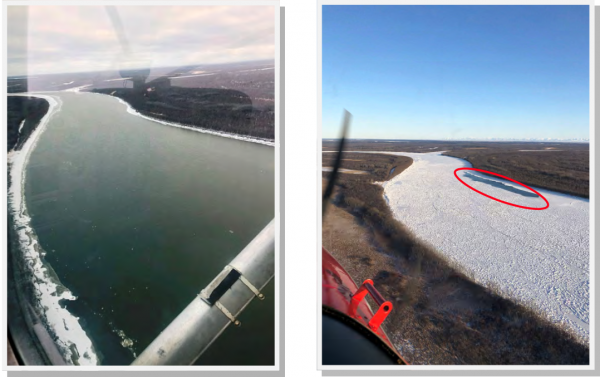
Despite a late freeze-up again this year, the Kuskokwim River looks different than it did at this time last year – in a good way. But Bethel Search and Rescue doesn’t think people should be revving up their snowmachines just yet.
Bethel Seach and Rescue Volunteer Mark Leary says that it’s still early, and there are still lots of small openings up and down the river. There’s an opening on Straight Slough that’s not small at all.
“Just about the entire slough from the upper end to the lower end is wide open,” Leary said.
Leary says that the other danger right now is shell ice. That’s when the water level below the ice drops, leaving a thin sheet with open water underneath. He says that this occurs most frequently around the riverbank where you get on and off the main ice. Leary is also worried about all the snow that came down yesterday.
“This is exactly the kind of weather we did not want yet,” Leary said. “The snow insulates the ice from the cold.”
Despite his concerns, Leary still couldn’t help but smile as he flew from the Johnson River up to Tuluksak on Monday.
“I was so happy with what we saw from the air yesterday. Just happy,” Leary said. “Looking forward to maybe we’re gonna have a normal, is there such a thing? Normal winter?”
Leary compares pictures of the river from the same time last year. This year’s pictures feature considerably less open water.
“Last year, Kuskokwak Slough, the whole length was wide open. This year it’s packed in very well with rough ice,” Leary said.
He also points out that the ice has lots of ridges this year. That rough ice, he says, is a good thing.
“Rough ice is safer because it’s jumbled up and it’s generally thicker,” Leary explained.
He says that the ridges also force people to ride slower, so they have a better chance of seeing open holes. Leary says that in the next month, BSAR will start marking those holes with willow trees and reflective tape if they stay open.
“Whenever you see willows on the ice close together, that’s an open water area or very thin ice. Stay away from it,” Leary warned.
Leary expects BSAR to have those areas marked by Christmas or earlier. He wants to give the ice more time to thicken before he goes out on the river. He says that BSAR will conduct another aerial survey from Tuluksak to Aniak later this week.




